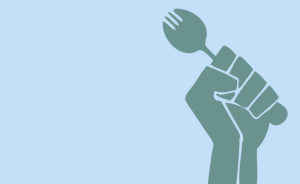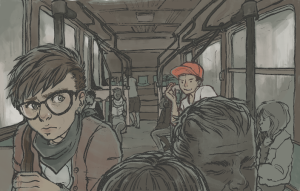
Source: Everyday Feminism / Decolonizing Yoga
Originally published in Civil Eats and republished here with the author’s permission.
In the wake of the unrest in Ferguson, Missouri, after the death of Michael Brown, the Baltimore uprising after the death of Freddie Gray, and the emergence of the Black Lives Matter movement, much has been written about the nature of poverty and violence in American cities.
But one aspect that is chronically underreported is the lack of access to healthy foods in many of those same communities.
Indeed, the reliance on a highly processed food supply is causing disease, suffering, and eventual death, especially to those in the poorest of neighborhoods.
A report released this June by the Johns Hopkins Center for a Livable Future found that one in four Baltimore residents lives in an under-resourced area or “food desert” (a term that some food activists reject).
This is not unusual or unique to Baltimore, but is the standard in urban centers throughout the country. Only 8% of Black Americans live in a community with one or more grocery stores, compared to 31% of white Americans.
And while food is by no means at the center of the Black Lives Matter movement, it could emerge as an important corollary issue in the months and years to come.
“The fact is, I can’t get an organic apple for ten miles,” said Ron Finley, known as the “gangsta gardener,” who lives in South Central, Los Angeles.
“Why is it like that? Why don’t certain companies do business in these so-called communities? ‘Oh there’s no money,’ they say. There’s money. If there’s no money, than why are there drugstores here? Why are the dialysis centers here? Why are there fast food restaurants? What there is, is disregard for these places.”
The disregard that Finley speaks of has vast implications for the health of people living in areas with little access to healthy, whole foods.
Meaning that a significant threat to Black lives comes from our food supply itself – from the glut of fast food and other highly processed food options and the virtually unregulated chemical additives that lace these foods.
The rates of diet-related disease break down dramatically along racial lines. Black Americans get sick at younger ages, have more severe illnesses, and die sooner than white Americans.
The American Journal of Public Health found that Black Americans scored almost 50% higher than whites on a measurement called Allostatic Load, the ten biomarkers of aging and stress. While there are clearly multiple factors at work, diet plays a significant role in these findings.
According to the Centers for Disease Control and Prevention, one in two Black Americans born in the year 2000 is expected to develop type 2 diabetes. Compared with white adults, the risk of diabetes is 77 % higher among Black Americans. And the rates of death from heart disease and stroke are almost twice as high.
Just as our economy has become starkly stratified with wealth concentrated at the top, it is increasing clear that we live in a two-tiered food system in which the wealthy tend to eat well and are rewarded with better health, while the poor tend to eat low-quality diets, causing their health to suffer.
A report released last year by the Harvard School of Public Health found that while diet quality improved among people of high socioeconomic status, it deteriorated among those at the other end of the spectrum, and the gap doubled between 2000 and 2010.
Black Americans experience the highest rate of poverty in the US – 25.8%, compared to 11.6% of whites. And 45.8% of young Black children live in poverty compared with 14.5% of white children.
Dr. Marvin L. “Doc” Cheatham, Sr., President of the Matthew A. Henson Neighborhood Association in Baltimore said he sees this in his community. “Stop allowing there to be two Baltimores,” he wrote in an email. “Have the Health Department and our elected officials place more funding and more emphasis on poorer, neglected communities.”
The solution to food inequality has traditionally been framed as a problem of access and education: Bring healthy foods into under-served communities and educate those living there on healthy eating, the argument goes.
But just as getting oneself out of poverty is far more complicated than working hard and getting an education, maintaining a healthy body by “choosing” to eat well is far more complex than making simple decisions about what to eat in our current food landscape.
In both cases, the ideology of “personal responsibility” is invoked, which fails to address deeper, structural issues like the myriad causes and effects of poverty.
As author and University of California Santa Cruz professor Julie Guthman puts it, “Built environments reflect social relations and political dynamics…more than it creates them.”
When we frame the problem in terms of simplistic solutions, like “better access to fruits and vegetables” or “education about healthy eating,” the underlying structures remain and the food, agricultural, and chemical industries are not impacted at all.
As Ta-Nehisi Coates’ writes in his new book Between the World and Me, “The purpose of the language of…‘personal responsibility’ is broad exoneration.”
I asked Karen Washington, a food activist and farmer at Rise & Root Farm in the Bronx, what she thought about creating better access in “food deserts.”
“Bringing a grocery store into food insecure neighborhoods is not the answer,” she wrote in a recent e-mail. “What needs to be addressed is the cause of food insecurity – the reason for hunger and poverty. Do you really think that bringing a supermarket into an impoverished neighborhood, where people have no jobs and no hope is the solution? Heck no!”
According to the latest US Department of Labor report, the rate of Black unemployment is more than double the rate of white unemployment – 9.1% and 4.2%, respectively.
Workers wages have been stagnant across the board for the past decade, but for Black workers, wages have fallen by twice as much as they have for whites in the past five years.
Washington says that the bottom line is that people need jobs.
“No one talks about job creation, business enterprises, or entrepreneurships in low-income communities,” she said. “We have to start owning our own businesses, like farmers’ markets, food hubs, and food cooperatives. When you own something it gives you power.”
Finley wants to see more people growing food for themselves and their neighbors. He says the focus is too often merely about bringing food into communities.
“People don’t have any skin in the game. I want people to have some kind of hand in their food. I don’t care how rich you are, if you don’t have a hand in your food, you’re enslaved,” he said.
Of course, it’s critical to point out that for many people of color, the danger of immediate bodily harm is far more pressing than concerns about long-term health effects.
As Washington sees it, it doesn’t make sense to apply the Black Lives Matter Movement directly to food.
“The only correlation is that people are tired of the injustices that plague their communities each and every day and are starting to take action and matters into their own hands,” she said.
But it’s also clear that the Black Lives Matter movement is expanding.
“We are broadening the conversation around state violence to include all of the ways in which Black people are intentionally left powerless at the hands of the state,” reads the group’s website.
It’s crucial to bring issues around food and health into dialogue with discussions of structural racism, poverty, and violence in this country.
“What are they feeding us if we have more diseases than we’ve ever had before in certain communities?” asks Finley. “You have asthma, hypertension, diabetes…and all of this stuff is food-related.”
Finley says this makes for an obvious connection to the Black Lives Matter movement: “We’re under siege and a lot of these communities are being occupied and terrorized – by food companies,” he said.
[do_widget id=’text-101′]
Kristin Wartman is an author and journalist. Her writing has appeared in The New York Times, The Atlantic, Grist, and Civil Eats. Kristin is the author of the forthcoming book, Formerly Known As Food, to be published by St. Martin’s Press. She writes on the intersections of food, health, politics, and culture. Kristin lives in New York City. Read more of her writing at kristinwartman.com.
Search our 3000+ articles!
Read our articles about:
Our online racial justice training
Used by hundreds of universities, non-profits, and businesses.
Click to learn more



















